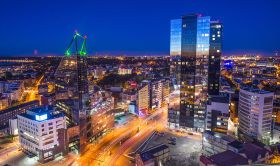Analytics, Economics, Estonia, GDP, Good for Business, Statistics
International Internet Magazine. Baltic States news & analytics
Sunday, 28.12.2025, 05:57
The Estonian economy grew last year
 Print version
Print version |
|---|
In 2016, the GDP at current prices was 20.9 bln euros.
The year was characterised by a slow but steady growth of the GDP. In different quarters of 2016, the increase in value added in the activities of trade, information and communication as well as transportation influenced the growth of the Estonian economy the most. In the last three years, transportation slowed the economy the most, and its decline continued in the 1st quarter. However, from the 2nd quarter onwards transportation contributed positively to the GDP growth at real prices.
In 2016, more than half of economic activities influenced the economy positively. Information and communication contributed to the increase of the GDP the most due to the strong growth in software development services. The growth of value added of trade was the highest in the comparison of the last four years mainly due to a stable growth in retail and wholesale trade. Although the value added of the largest Estonian activity, manufacturing, decreased in the 1st quarter, the value added increased 0.8% in total in 2016.
In 2016, net taxes on products influenced the Estonian economy positively. The receipts from value added and excise taxes grew. In addition, payments of subsidies increased.
After a decline in 2015, the real exports of goods and services rose by 3.6% in 2016 (including the exports of services by 4.9%). The real imports of goods and services increased 4.9%. The exports of goods and services were mainly affected by increased exports of electrical equipment, wood and products of wood and electronic equipment. The imports of goods and services was affected by the rise in the imports of motor vehicles, base metals, pharmaceutical products and chemicals. The impact of the exports and imports of the remaining commodity groups was modest. Net exports, i.e. the difference between exports and imports, was positive in 2016. The share of net exports in the GDP was 4%, which was the same level as in 2015.
In 2016, domestic demand increased 2.6%, affected mainly by increased household consumption expenditures. The increase in household final consumption expenditures was mostly caused by a rise in expenditures on transportation, food and recreation. In addition, the general government and non-profit institutions’ final consumption expenditures increased. Real gross fixed capital formation decreased 2.8% mainly due to less investments in buildings and structures by enterprises and in equipment and machinery by the government sector. Domestic demand grew faster than the GDP. The total final consumption expenditures, gross fixed capital formation and changes in inventories was smaller than the GDP by output method, totalling 97.7% of the GDP.
4th quarter of 2016
The GDP at current prices was 5.6 billion euros in the 4th quarter of 2016.
In the 4th quarter of 2016, the Estonian economy grew 2.7% compared to the 4th quarter of 2015. In the 4th quarter, the seasonally and working-day adjusted GDP increased by 1.9% compared to the 3rd quarter of 2016, and by 2.8% compared to the 4th quarter of 2015.
The GDP in the last quarter of 2016 was driven the most by a rise of value added in the information and communication activity due to an increase in software development services. Furthermore, the value added in trade, transportation, energy, administrative and support service activities, manufacturing and construction also provided significant support for economic growth. Compared to recent years, more economic activities contributed positively to the GDP growth.
In the 4th quarter, the number of persons employed and hours worked decreased, but the GDP increased. Therefore, compared to the same quarter of the previous year, labour productivity per employee and labour productivity per hour worked increased. Unit labour cost increased 2.5% in the 4th quarter of 2016.
After decreasing in the 3rd quarter, in the 4th quarter of 2016 the domestic demand grew 3.7% in real terms, compared to the 4th quarter of 2015. Domestic demand was mainly affected by enterprises’ increased inventories of goods and increased final consumption expenditures. In the 4th quarter, real gross fixed capital formation fell 5.5% mainly due to a decrease of investments in buildings and structures by the enterprise sector. At the same time, investments of enterprises in equipment and machinery increased. For all other sectors, gross fixed capital formation grew compared to the previous year.
In the last quarter of 2016, the real exports of goods and services increased 2.7% and the real imports of goods and services 2.4%, compared to the same quarter of the previous year. The exports of goods and services grew due to an increase in the exports of electronic equipment, mineral products and wood and of products of wood. The imports were affected positively by other transport equipment and base metals. The share of net exports in the GDP was 3.3%.








 «The Baltic Course» Is Sold and Stays in Business!
«The Baltic Course» Is Sold and Stays in Business!

